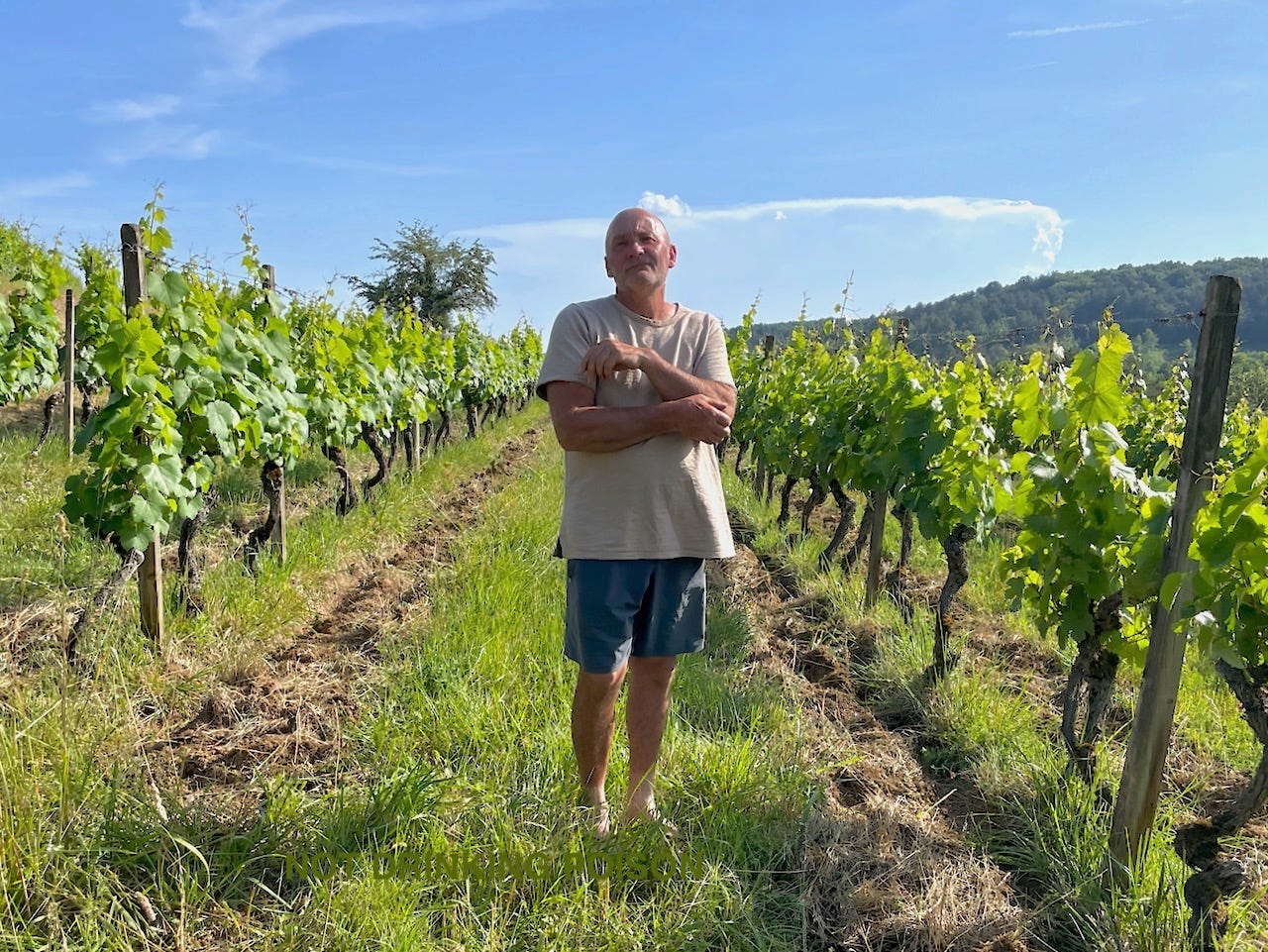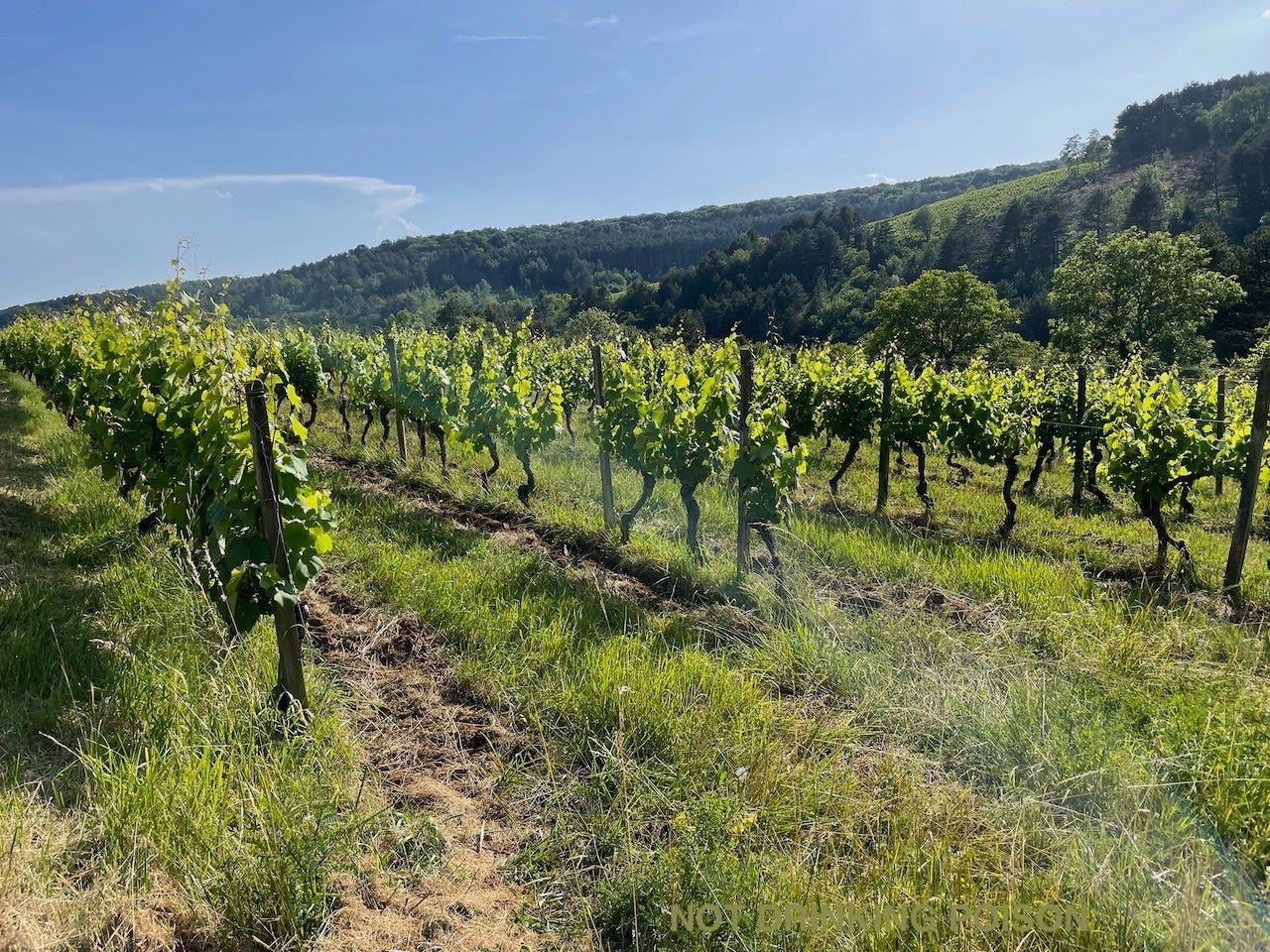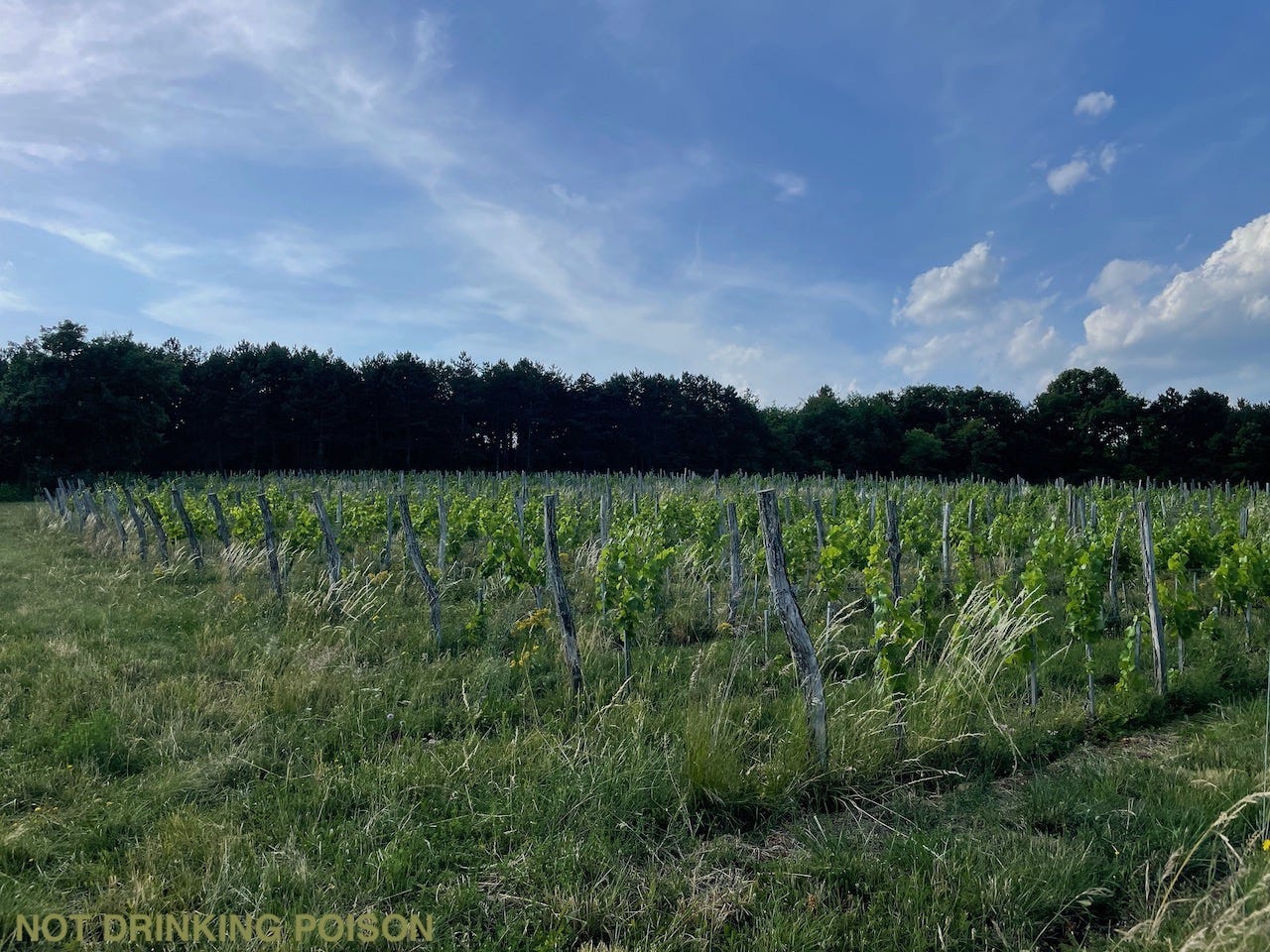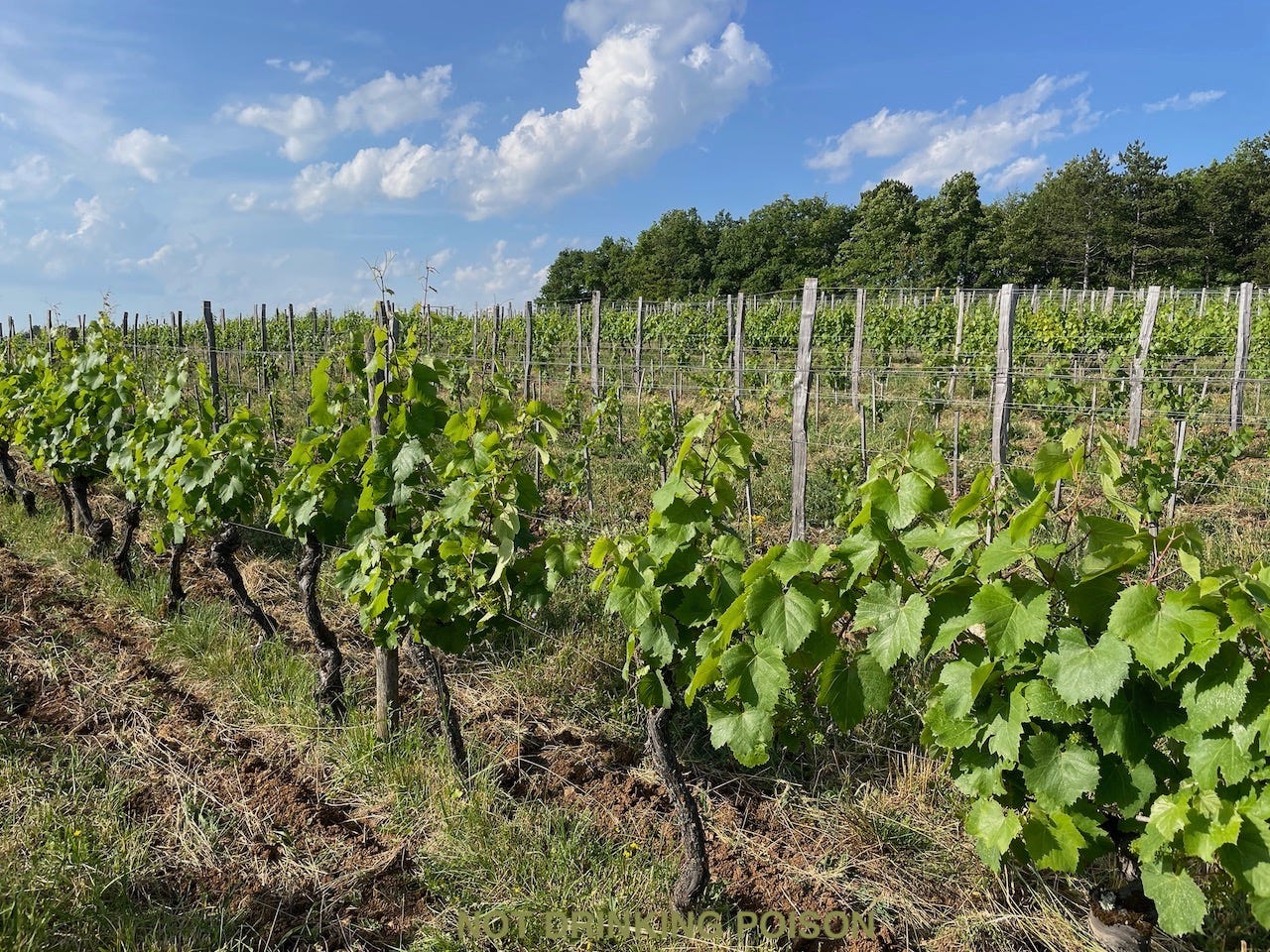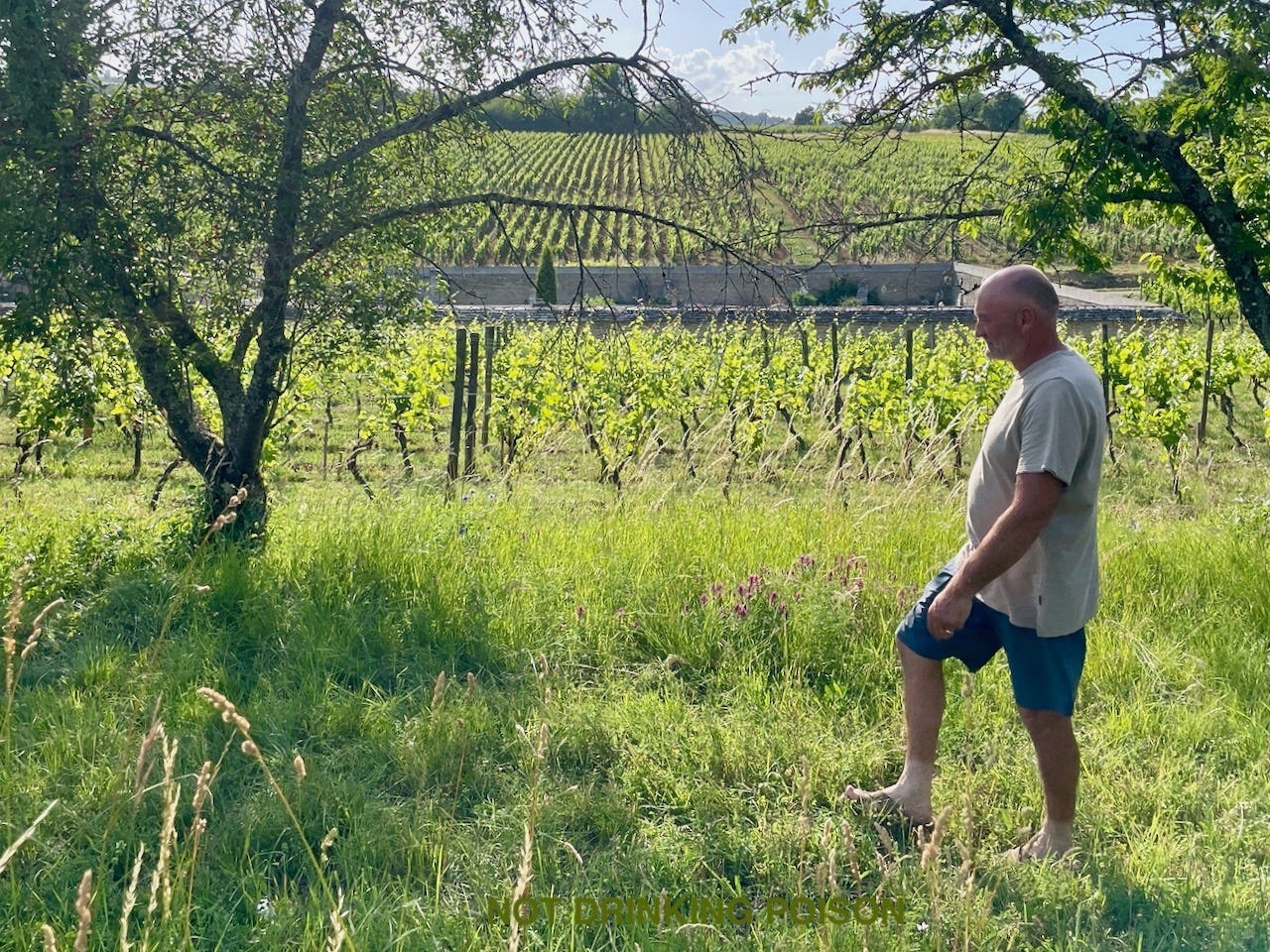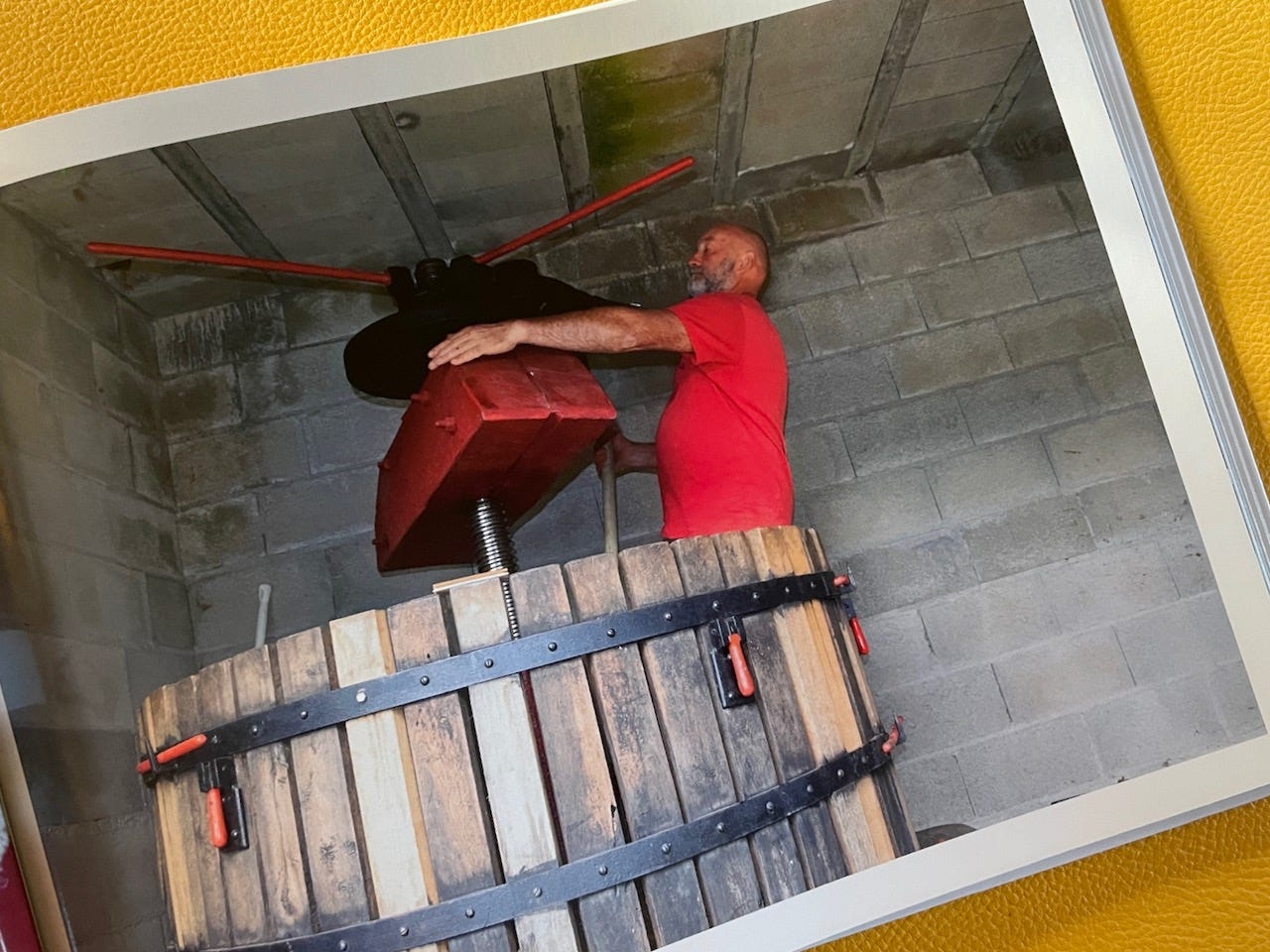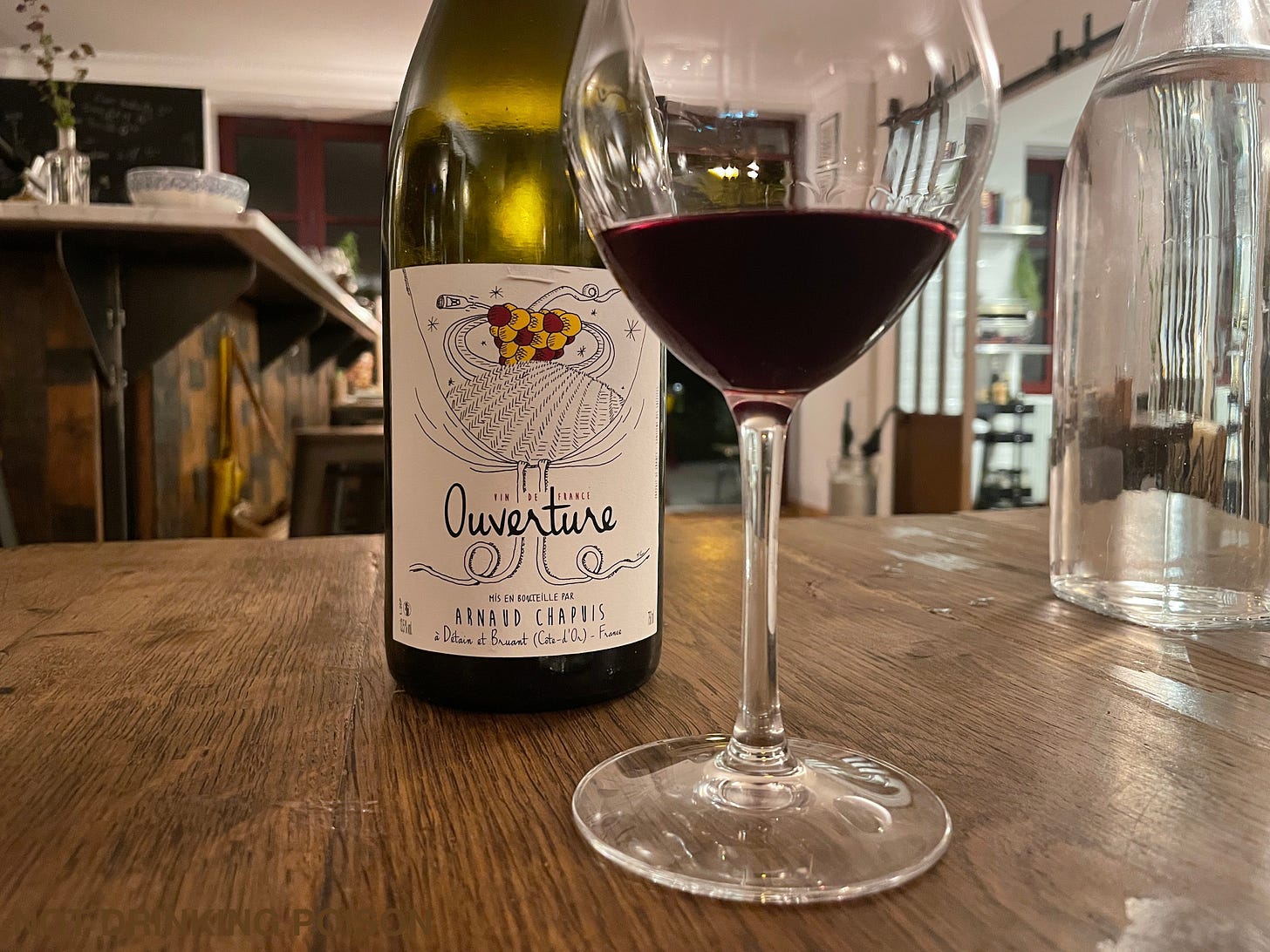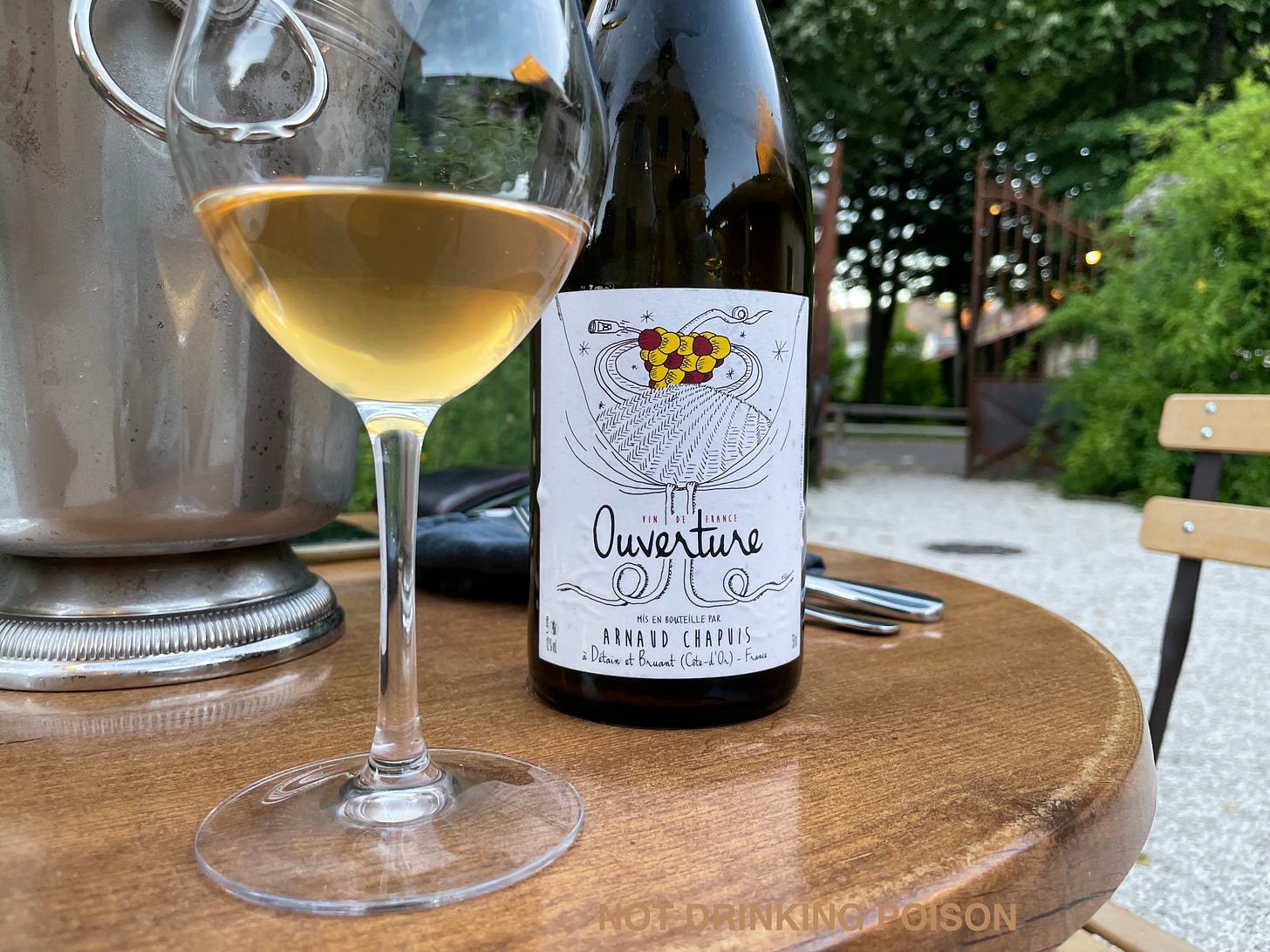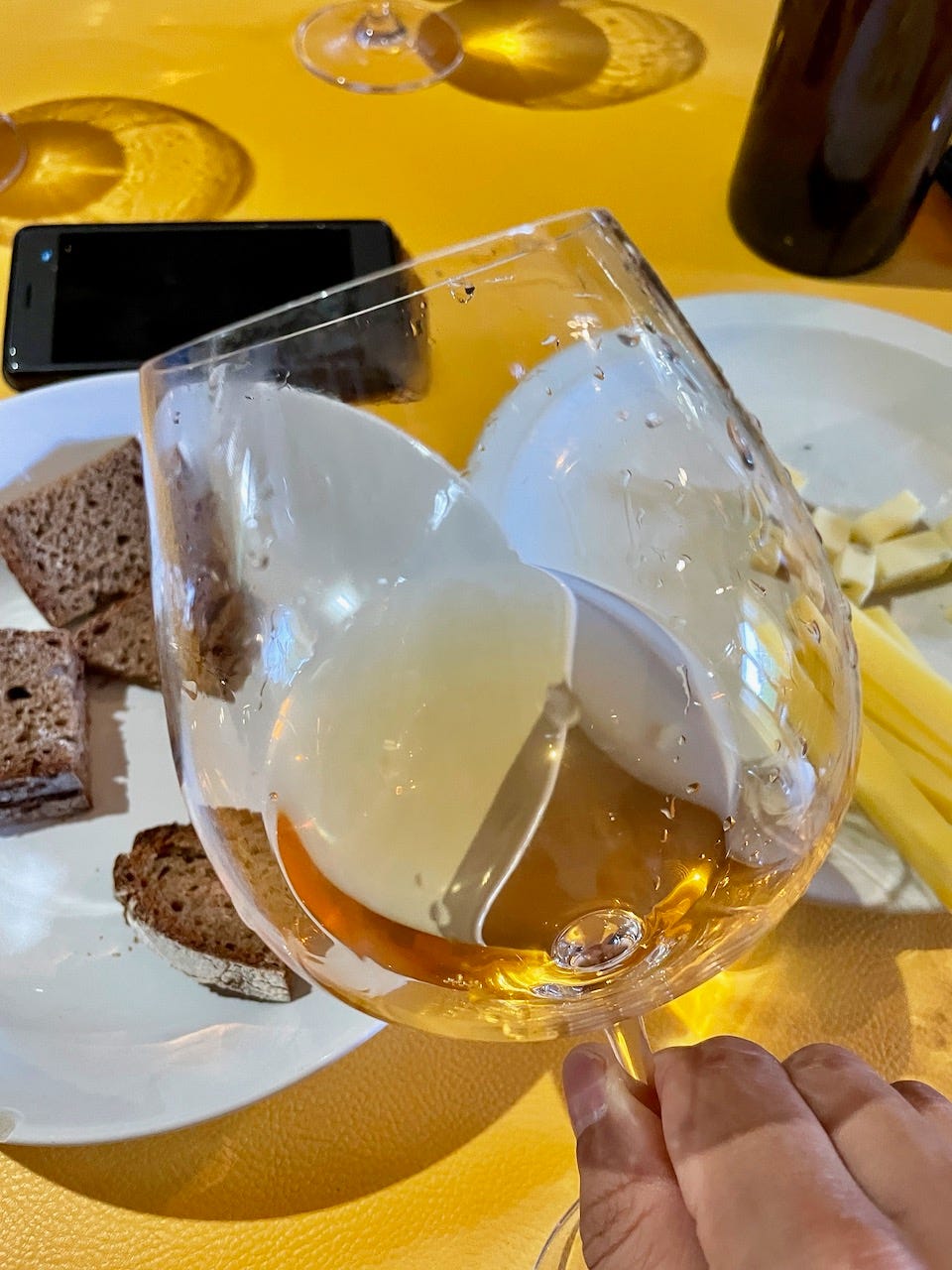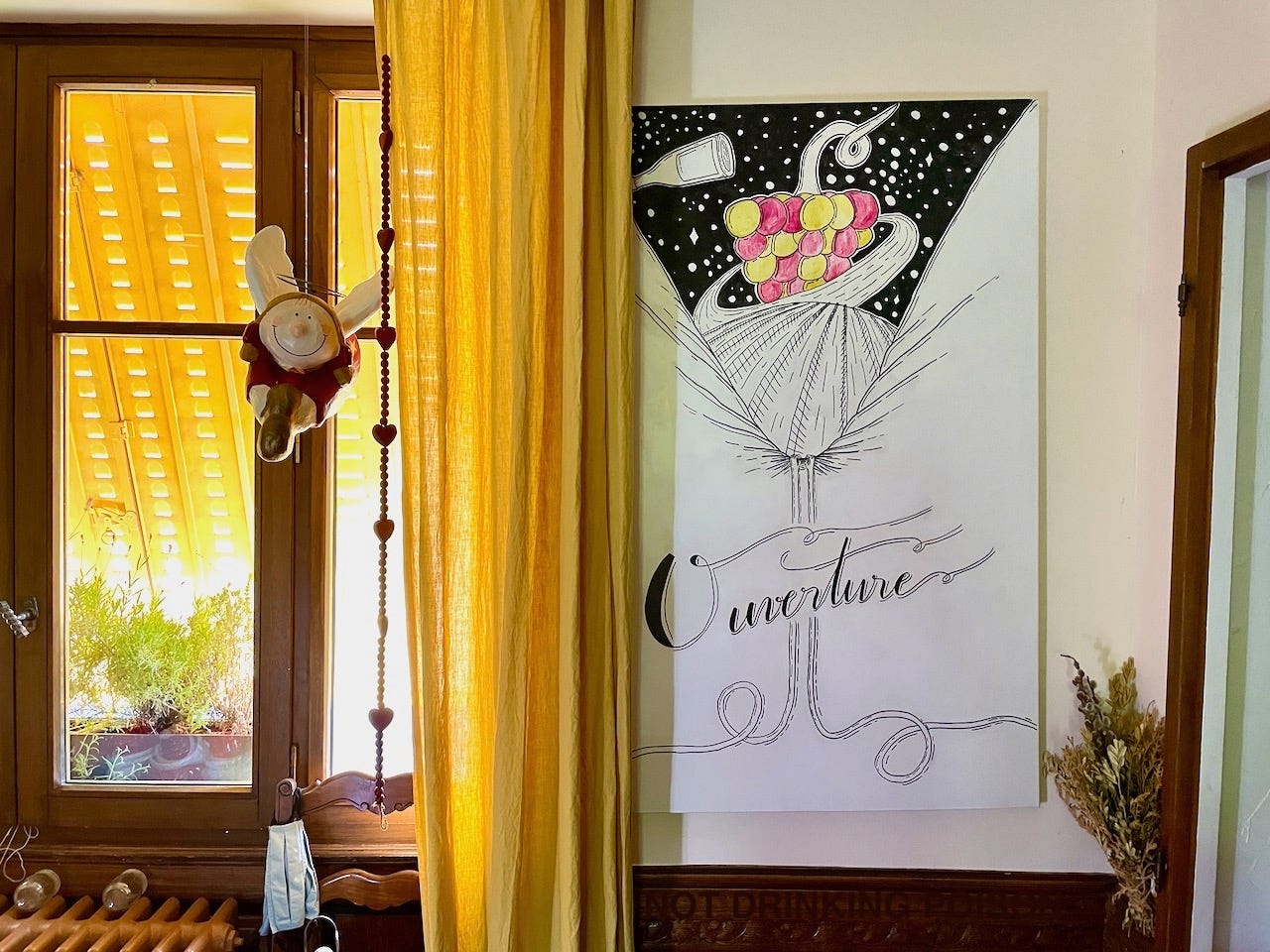The Primitive Art of Arnaud Chapuis
A vineyard tour with the singular Hautes Côtes vigneron, whose intense, homespun Hautes Côtes aligotés and pinot noirs are peerless in modern Burgundy.
A true radical natural wine original, Arnaud Chapuis (no relation to Domaine Chapuis or Chapuis Frères) is a native of the Hautes Côtes de Beaune who led a career in mining in Comblanchien before embracing vineyard work in 2011. In 2014, Chapuis began farming 1.5ha of his grandfather’s aligoté and pinot noir near Echevronne in the Hautes Côtes, to which surface he has since added another 1.5ha of pinot noir plantings, which should enter into production this year.
From the start, Chapuis’ work was characterized by a bold level of grass cover in his wide-planted, organic vineyards, extremely low yields, and a total refusal of additives or modern artifice in vinification. The wines, bearing loopy, faintly suggestive label art by his son Yohan, are quiet masterpieces. (His ripe, granular aligotés are particularly unique.) It is tempting to read, in their homespun aesthetic, a rebuke to the total professionalization of viticulture and winemaking in surrounding Burgundy.
I was put in touch with Chapuis by my friends Svante Forstorp and Layla Aouba of Le Soleil, where Chapuis’ Austrian wife Emmanuelle also works from time to time. In mid-June I joined the Chapuis for a tour of their parcels and a leisurely tasting at their home in Détain.
Quick Facts
Arnaud Chapuis began producing his own wine in 2014, from 1.5ha of aligoté and pinot noir inherited from his grandfather. He planted another 1.5ha of pinot noir on a nearby hilltop site in 2018. All vines are farmed organically, with minimal plowing.
Since 2016, Chapuis has also worked for Domaine Chandon de Briailles. Previously he did vineyard work at Prieuré Roch.
Yields are very low: between 15-20HL/ha in a normal year.
All wines are released with the same label bearing the title “Ouverture.” Cuvées vary according to the year, but there tends to be a pétillant naturel from aligoté, a direct-press aligoté, a macerated aligoté, and a pinot noir. Pinot noir is generally vinified entirely whole cluster, with a small pied de cuve, with a short vatting of about a week.
Chapuis employs a manual vertical press situated at his parents’ house in Echevronne. The press is, significantly, very long, at 20-24 hours. Musts are then transferred, either in barrel or tank, to the Chapuis’ cellar at their home in Détain.
ON THE PRIMITIVE AND THE PROFESSIONAL
“Art-historically, the word primitive has been used in three different ways: to designate art (before Raphael) on the borderline between medieval and modern renaissance traditions; to label the trophies and “curiosities” taken from the colonies (Africa, Caribbean, South Pacific) when brought back to the imperial metropolis; and, lastly, to put in place the art of men and women from the working classes - proletarian, peasant, petit-bourgeois - who did not leave their class by becoming professional artists.” - John Berger, “The Primitive and the Professional” (1976)
Hautes Côtes vigneron Arnaud Chapuis, like many genuine artists, is not given to interpreting his own work. In his vineyards as, later, at his dining room table, he shows the work in consideration, and awaits its effect upon his interlocutor. One does not interview Arnaud Chapuis, as such; one instead feels oneself being tested, under his matter-of-fact gaze, for the correct responses to the work.
When we arrive at the 60-are stretch of aligoté and pinot noir that belonged to Chapuis’ grandfather, near the border of Pernand-Vergelesses, it is a blinding late afternoon during an incipient May heat wave. I remark the site’s unusually wide planting and high training; the tallness of the grass; how it is planted perpendicular to the gentle low hill. Then I surely ruin my first impression, by admitting I can’t tell the difference between aligoté and pinot noir plants at this stage. (Chapuis shows me the red stems of the aligoté, the green stems of the pinot, an obvious indicator.)
Chapuis confirms the site is planted at 3000 plants per hectare, rather than the 10,000 that is more common in Burgundy. He says before the 1970s, it was planted as elsewhere, low and dense, but the mixed agricultural farmers of the era adapted the site to accommodate the tractors they used in their other crops. Many did yields of 80 or 100HL/ha. Chapuis generally does between 15-20HL/ha.
“It’s better for what goes in the bottles,” he adds, drily.
After sampling the sour cherries on the trees that demarcate the beginning and the end of Chapuis’ parcel, we drive to his young pinot plantings on a hilltop site, beside a forest, at the northernmost limit of the Hautes Côtes de Beaune appellation.
It’s planted slightly denser, but not much. The clay is redder and stonier here. The parcel came with the forest; on the forest’s other side, on a windswept, west-facing slope, is another of Chapuis’ parcels, consisting of aligoté planted in the 1930s, two rows of pinot noir from the 1950s, and a few more rows of young vine pinot.
“Here there’s much more wind, so almost no maladies,” says Chapuis. “But there’s not much soil. Hot years are really hard for the vines. I’m practically on the summit of the hill, so there’s no water runoff.”
Indeed, from the vantage here, we can see Chapuis’ sixty ares between the cherry trees in the valley below.
“We can see if someone’s stealing the cherries,” he notes.
Next we drive to the cemetery of Echevronne, where Chapuis has pinot noir, along with cherry, apple, and pear trees. (The site gives a whole new meaning to the notion of ancestral terroir.)
Like his friend (and Chandon de Briailles coworker) Christian Knott of Domaine Dandelion, Chapuis takes an interest in cider and poiré, producing a few bottles now and then for personal consumption.
Our last stop, before returning chez Chapuis to taste wine, is to his parents’ house in Echevronne, so Emmanuelle can recover the couples’ other car. Chapuis briefly notes the column of his manual vertical press, visible within the garage. He presses whites and reds here before transferring the juice to his home cellar in tank or barrel. The house itself is a peculiar, vaguely Modernist wooden construction. I don’t exit the car. But this one glimpse - of Chapuis parents’ house, and his manual vertical press - is among the more revelatory moments of my visit.
“My in-laws have always been like that,” says Emmanuelle. “Stylish.”
Chapuis’ parents arise later in conversation, when I ask what led him to choose to produce wines without additives (including sulfites) or filtration. He claims it was just “logical,” for someone with such a small vineyard surface, “to do something different.”
“But it was also a question of education,” Emmanuelle points out. “My in-laws have always been a bit like that. Always in nature. They practice homeopathy. It’s a way of life. To make conventional wine would never have been in the spirit of the family.”
At his dining room table, Chapuis offers tastes of wines retrieved from tank, dame jeanne, and bottle in the cellar, initially without narration. His 2020 pinot noir is intense, dark-berried, and saline, displaying none of the fatness or lack of direction that typifies the vintage in many other cellars.
One sip of his glowy, quince-toned, nominally direct-press aligoté is enough for me to hazard a guess that he conducts a very long, soft press. Twenty-to-twenty-four hours, he confirms.
The result of this light maceration within the wine press (and, of course, Chapuis’ sensitive farming and very low yields) is an aligoté without peer, closer, stylistically, to the terret of L’Absurde Génie des Fleurs than to any aligoté I can think of.
It was the wines of L’Absurde Génie des Fleurs that first confirmed, for me, the vast potential of small-scale, radically handmade natural winemaking on traditional grapes in the Languedoc, where the local wines essentially encountered modernity via the common practices of the cave cooperative (large volumes, destemming, etc).
The purity and grace of Arnaud Chapuis’ wines confirm the counterintuitive proposition that even the wines of Burgundy - famous for its artisanship, its tiny parcels, etc. - stand to gain from a non-professionalized, or less professionalized, approach to viticulture and vinification. By this I mean greater grass cover in the vines; drastically lower yields; time-consuming, labor intensive press work; unhurried fermentations; zero sulfite addition, etc. Professional vignerons avoid these things because they are seen as incompatible with financial well-being.
Vignerons who are primitive artists, rather than professional ones, make other sacrifices to avoid adapting their art to the limits of economic feasibility. Arnaud Chapuis does vineyard work for Domaine Chandon de Briailles. Emmanuelle Chapuis worked twenty-five years in wine tourism and hospitality for Clos de Vougeot; more recently she’s worked for Le Soleil in Savigny-lès-Beaune, and the Moutarderie Edmond Fallot. The couple have three sons.
Arnaud Chapuis
34 route de Détain
21220 DETAIN-ET-BRUANT
FURTHER READING
A profile of Arnaud Chapuis on the website of a new-ish wine shop in Beaune, AVintures.
Domaine Dandelion Branches Out
My May 2022 interview with Svante Forstorp and Laila Aouba of Le Soleil in Savigny-lès-Beaune.

